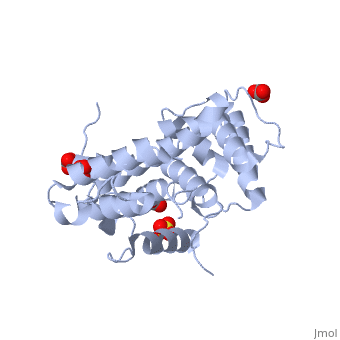2wa5
From Proteopedia
Crystal structure of human filamin B actin binding domain at 1.9 Angstroms resolution
Structural highlights
DiseaseFLNB_HUMAN Note=Interaction with FLNA may compensate for dysfunctional FLNA homodimer in the periventricular nodular heterotopia (PVNH) disorder. Defects in FLNB are the cause of atelosteogenesis type 1 (AO1) [MIM:108720; also known as giant cell chondrodysplasia or spondylohumerofemoral hypoplasia. Atelosteogenesis are lethal short-limb skeletal dysplasias with vertebral abnormalities, disharmonious skeletal maturation, poorly modeled long bones and joint dislocations.[1] Defects in FLNB are the cause of atelosteogenesis type 3 (AO3) [MIM:108721. Atelosteogenesis are short-limb lethal skeletal dysplasias with vertebral abnormalities, disharmonious skeletal maturation, poorly modeled long bones and joint dislocations. In AO3 recurrent respiratory insufficiency and/or infections usually result in early death.[2] Defects in FLNB are the cause of boomerang dysplasia (BOOMD) [MIM:112310. This is a perinatal lethal osteochondrodysplasia characterized by absence or underossification of the limb bones and vertebre. Boomerang dysplasia is distinguished from atelosteogenesis on the basis of a more severe defect in mineralisation, with complete absence of ossification in some limb elements and vertebral segments.[3] Defects in FLNB are the cause of Larsen syndrome (LRS) [MIM:150250. An osteochondrodysplasia characterized by large-joint dislocations and characteristic craniofacial abnormalities. The cardinal features of the condition are dislocations of the hip, knee and elbow joints, with equinovarus or equinovalgus foot deformities. Spatula-shaped fingers, most marked in the thumb, are also present. Craniofacial anomalies include hypertelorism, prominence of the forehead, a depressed nasal bridge, and a flattened midface. Cleft palate and short stature are often associated features. Spinal anomalies include scoliosis and cervical kyphosis. Hearing loss is a well-recognized complication.[4] [5] Defects in FLNB are the cause of spondylocarpotarsal synostosis syndrome (SCT) [MIM:272460; also known as spondylocarpotarsal syndrome (SCT) or congenital synspondylism or vertebral fusion with carpal coalition or congenital scoliosis with unilateral unsegmented bar. The disorder is characterized by short stature and vertebral, carpal and tarsal fusions.[6] FunctionFLNB_HUMAN Connects cell membrane constituents to the actin cytoskeleton. May promote orthogonal branching of actin filaments and links actin filaments to membrane glycoproteins. Anchors various transmembrane proteins to the actin cytoskeleton. Interaction with FLNA may allow neuroblast migration from the ventricular zone into the cortical plate. Various interactions and localizations of isoforms affect myotube morphology and myogenesis. Isoform 6 accelerates muscle differentiation in vitro. Evolutionary ConservationCheck, as determined by ConSurfDB. You may read the explanation of the method and the full data available from ConSurf. Publication Abstract from PubMedMissense mutations in filamin B (FLNB) are associated with the autosomal dominant atelosteogenesis (AO) and the Larsen group of skeletal malformation disorders. These mutations cluster in particular FLNB protein domains and act in a presumptive gain-of-function mechanism. In contrast the loss-of-function disorder, spondylocarpotarsal synostosis syndrome, is characterised by the complete absence of FLNB. One cluster of AO missense mutations is found within the second of two calponin homology (CH) domains that create a functional actin-binding domain (ABD). This N-terminal ABD is required for filamin F-actin crosslinking activity, a crucial aspect of filamin's role of integrating cell-signalling events with cellular scaffolding and mechanoprotection. This study characterises the wild type FLNB ABD and investigates the effects of two disease-associated mutations on the structure and function of the FLNB ABD that could explain a gain-of-function mechanism for the AO diseases. We have determined high-resolution X-ray crystal structures of the human filamin B wild type ABD, plus W148R and M202V mutants. All three structures display the classic compact monomeric conformation for the ABD with the CH1 and CH2 domains in close contact. The conservation of tertiary structure in the presence of these mutations shows that the compact ABD conformation is stable to the sequence substitutions. In solution the mutant ABDs display reduced melting temperatures (by 6-7 degrees C) as determined by differential scanning fluorimetry. Characterisation of the wild type and mutant ABD F-actin binding activities via co-sedimentation assays shows that the mutant FLNB ABDs have increased F-actin binding affinities, with dissociation constants of 2.0 microM (W148R) and 0.56 microM (M202V), compared to the wild type ABD K(d) of 7.0 microM. The increased F-actin binding affinity of the mutants presents a biochemical mechanism that differentiates the autosomal dominant gain-of-function FLNB disorders from those that arise through the complete loss of FLNB protein. Disease-associated substitutions in the filamin B actin binding domain confer enhanced actin binding affinity in the absence of major structural disturbance: Insights from the crystal structures of filamin B actin binding domains.,Sawyer GM, Clark AR, Robertson SP, Sutherland-Smith AJ J Mol Biol. 2009 Jul 31;390(5):1030-47. Epub 2009 Jun 6. PMID:19505475[7] From MEDLINE®/PubMed®, a database of the U.S. National Library of Medicine. Loading citation details.. Citations No citations found See AlsoReferences
|
| |||||||||||||||||||


